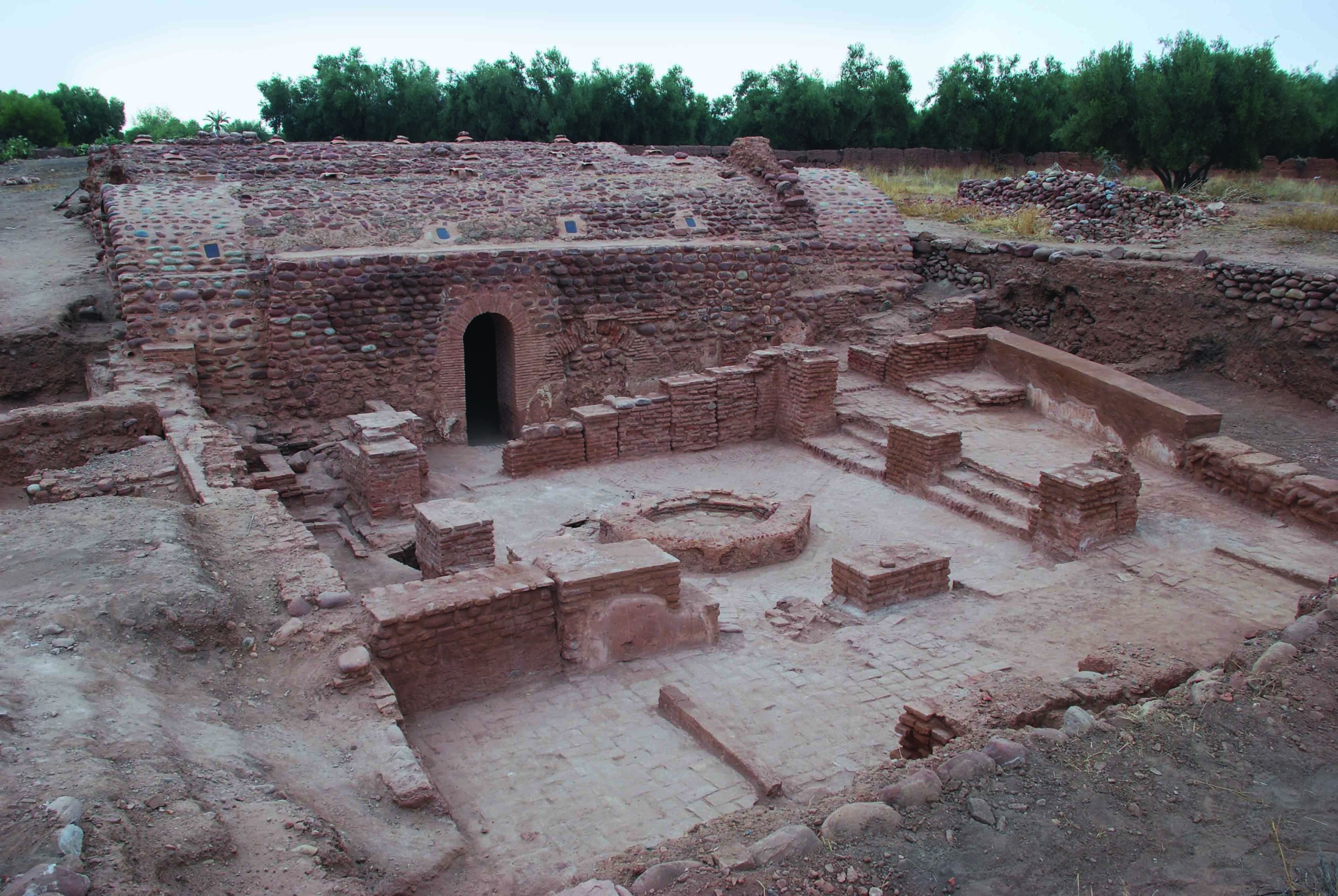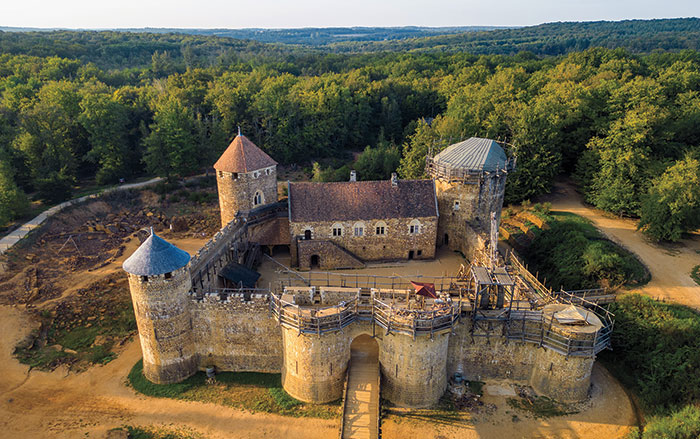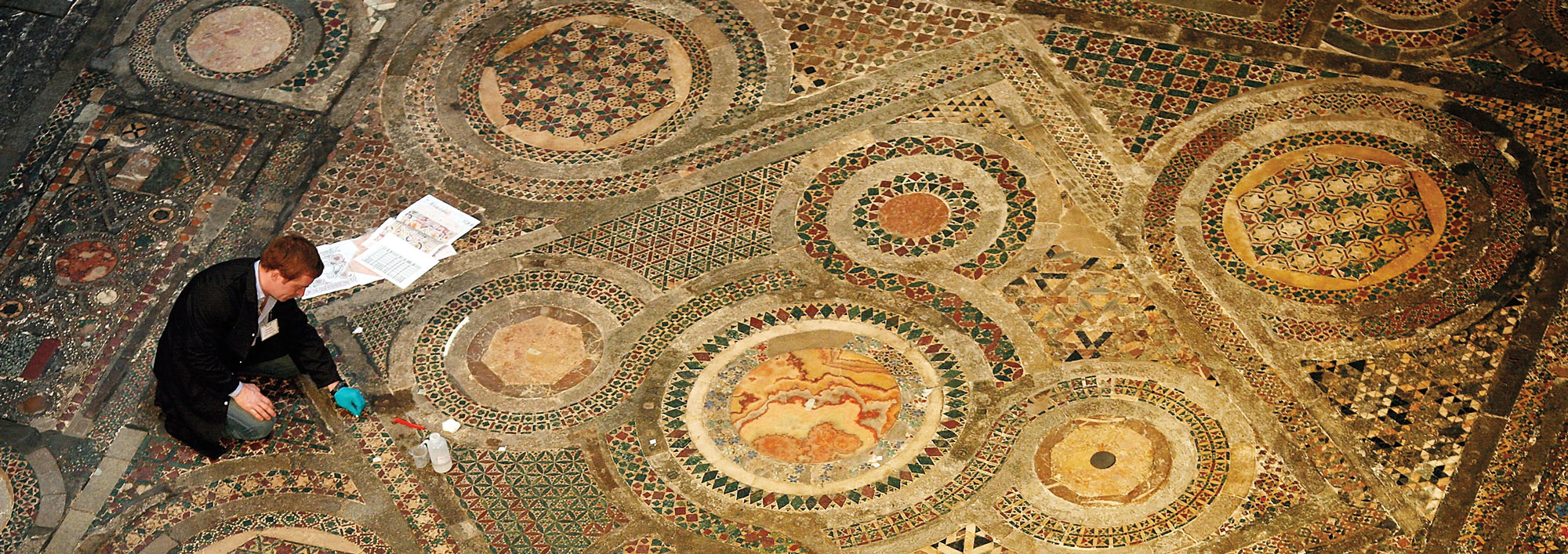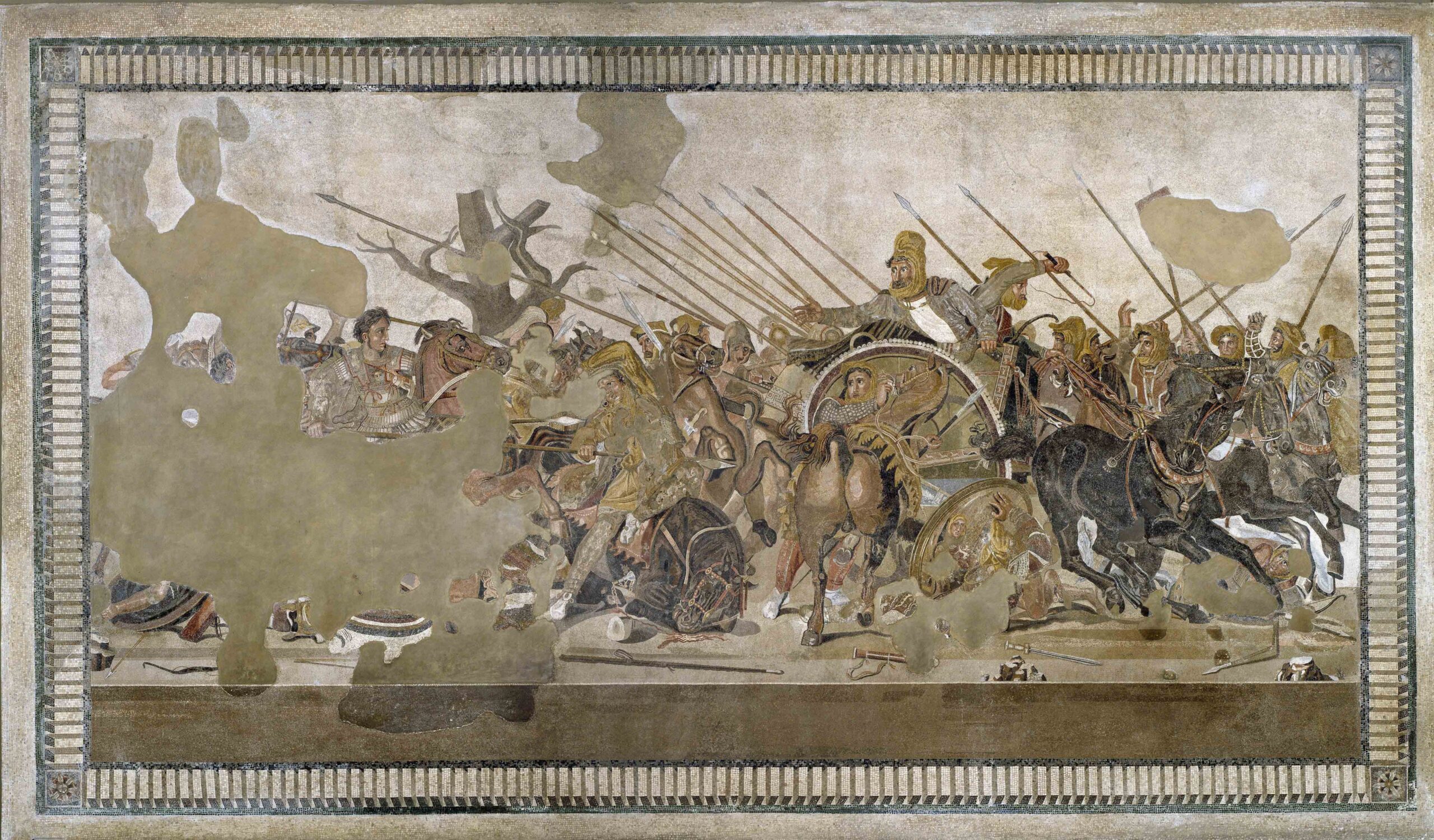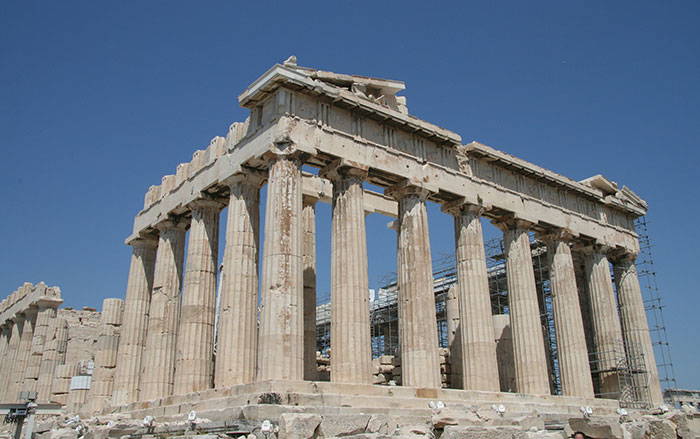
Fifteen years ago, retired archaeologist Ronald Messier, who had spent much of his career excavating the site of Sijilmasa on the northern edge of the Sahara, got a phone call from Frederick Vreeland, a former American ambassador to Morocco and the son of the fashion editor and columnist Diana Vreeland. Vreeland, who was also retired and lived on an estate just south of the bustling city of Marrakech, asked Messier to come and take a look at some nearby ruins that locals called the hammam, the Arabic word for bathhouse. Vreeland was concerned that something important might be slipping away from decay and neglect at the dilapidated site next to a slaughterhouse on the outskirts of the modern village of Ghmat.

Messier visited the site a few days later, and, after just a few minutes of inspecting the tops of three well-worn stone and brick domes poking out of the red soil amid the trash, was convinced it was, indeed, important. “I could tell from the pottery sherds scattered about that the remains went back to the Middle Ages,” says Messier, a professor emeritus at Middle Tennessee State University. “I knew that this was likely the ruins of medieval Aghmat.” The location of Aghmat, which is partially encircled by the foothills of the High Atlas Mountains, was not a mystery. From the ninth through fourteenth centuries, the city was a key trans-Saharan trading hub. It is well-known from contemporaneous texts and is even noted on a few modern maps. But while many travelers over the centuries had sketched the ruins, and the site was partially surveyed by French archaeologists in the 1990s, it had never been excavated.
Messier soon abandoned his retirement plans, and along with Abdallah Fili of Chouaib Doukkali University and Chloé Capel of the University of Paris, began excavating Aghmat in earnest. Thus far, the team has uncovered the large bathhouse whose domes Messier saw during his initial visit, along with a palace and mosque, residential villas, remains of water systems, parts of the ancient city walls, and thousands of artifacts. The rest of ancient Aghmat, which may once have extended over three-fourths of a square mile, still lies buried under the homes and farms of Ghmat. “This site has undeniable scientific value,” Capel says. “It’s an almost unique source of knowledge about medieval urban societies in North Africa, of which we know little.”

Until recently there had been relatively little scholarly interest in medieval archaeology in Morocco, says Fili, who also directs excavations at Igiliz, another recently identified medieval settlement in the Atlas Mountains. In the past, the country’s prehistoric and Roman-era remains have taken precedence in both funding and government conservation policies. The lack of a datable local ceramic record for the Middle Ages, an important time of transition when Islam and Arabic culture arrived and took root in Morocco, also makes study of the period difficult, Fili explains. Now, improved training and stricter cultural preservation laws have led to a growing number of medieval archaeology projects.
Excavations by Messier’s team provide a rare opportunity to examine the history of the Berbers, the descendants of the pre-Arab inhabitants of North Africa, some of whom made Aghmat their home. Amid the Arabs’ expanding power in the region during the Middle Ages, some of the indigenous Berbers forged an ever-shifting system of alliances. Despite coming from dozens of different tribes, many of which had their own languages and cultures, the Berbers created dynasties that ruled much of North Africa and Spain from the eleventh to sixteenth centuries. The Berbers lived in the mountains and the desert and were often nomadic. Thus, they were intimately familiar with the region’s topography. They derived much of the power and influence that later allowed them to form these dynasties by controlling sections of the important trade networks that crossed the harsh terrain of North Africa to reach Europe and the Mediterranean world.
But the Berbers, even to this day, have never been one political or cultural entity. In addition to the fact that tribes speak different, although closely related, languages of the Afroasiatic family, they have also embraced a diversity of religions, including the worship of solar and lunar gods, Judaism, Christianity, and Islam. Today, Berbers and people with at least some Berber ancestry still make up a large part of the population of Morocco, as well as neighboring Algeria. Although many Berbers are part of modern urban society in Morocco, there are regions, including the green valley and mountains around Aghmat, where some Berber tribes still pursue a traditional rural lifestyle, building homes from local red clay and raising goats or weaving baskets for a living.

In the seventh century, descendants of the prophet Muhammad, who had founded Islam earlier that century on the Arabian Peninsula, established the Umayyad Caliphate. In 680, the Damascus-based dynasty invaded Morocco in an effort to expand its growing empire. From there, the Umayyads, with the Berbers’ help, conquered southern Spain and established the Arab territory of al-Andalus. Although the Berbers in Morocco adopted Islam, they successfully revolted against Umayyad rule in 740, angry about what they saw as unfair taxation practices and the caliphate’s favoritism toward Arabs over other ethnic groups. As a result, much of the western part of North Africa was ruled once again by independent tribes. Despite the expulsion of the Umayyads, Islam and the Arabic language and culture persisted in Morocco and among the Berbers, who went on much later to found the first Moroccan non-Arab Islamic dynasty, the Almoravids. By the time the Almoravids came to power in the eleventh century, Aghmat, then ruled by another Berber tribe, was “the most important city in southern Morocco,” Messier says, and the Almoravids declared this thriving urban center their first capital.
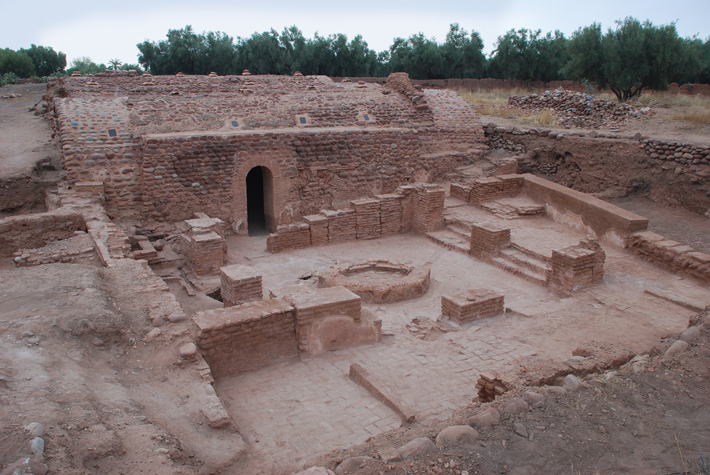
The earliest record of the name Aghmat appears on a silver coin identifying the city as the place where it was minted in 814 by the Idrisid Dynasty, Morocco’s first homegrown Islamic monarchy. The dynasty was founded in 789 by Idris I, a descendant of the prophet Muhammad who fled to Morocco after leading a failed rebellion in the Arabian Peninsula against the Abbasid Caliphate, another branch of Muhammad’s extended family that succeeded the Umayyads and ruled much of the Middle East at the time. Upon coming to North Africa, Idris married a Berber woman from the Awraba tribe, and became a leader among the indigenous people. He founded Fez, a trading post on the banks of the Jawhar River in northern Morocco that would later attract an influx of Arabic-speaking migrants from Spain and become a great economic and cultural center. From this well-placed settlement, the Idrisids went on to control a large part of what is now Algeria and Morocco. This sparked the ire of the Abbasid caliph Harun al-Rashid, who sent emissaries who poisoned Idris in 791. Idris’ son, Idris II, took power and ruled Algeria and Morocco, focusing his attention on the fertile areas north of the Sahara, including Aghmat. Until this point, Aghmat had been a simple agricultural settlement, but it was perfectly positioned to take advantage of the trans-Saharan trade, a growing network of camel caravans carrying salt, gold, and slaves between Europe, Africa, and the Middle East.
The first known textual reference to Aghmat appears in the writings of the ninth-century geographer Ahmad al-Yaqubi, who described it as a fertile region around the Ourika River, whose waters made the region suitable for farming. In 977, the Arab geographer Ibn Hawqal described Aghmat as a place of “merchandise going out and coming in,” and listed it among other important cities, including Fez. “Trade passing through places like Aghmat was central to the global economy,” says Kathleen Bickford Berzock, associate director of curatorial affairs at Northwestern University’s Block Museum. In addition to goods, Berzock says, trade also moved ideas, spreading Islam as well as artistic and architectural styles. It also united disparate geographic regions and different cultures. After Idris II’s death, the Idrisid Dynasty split into several self-ruling states, each headed by descendants of the caliph, who were fully integrated by marriage into Berber society. Aghmat was part of one of these states, ruled by the local Zenata Berbers, who had been one of the first tribes to adopt Islam and an early ally of the Idrisids. According to the writings of eleventh-century historian al-Bakri, the city had a population wealthy enough to slaughter 100 cattle and 1,000 sheep for its weekly market. It also minted its own gold coins.
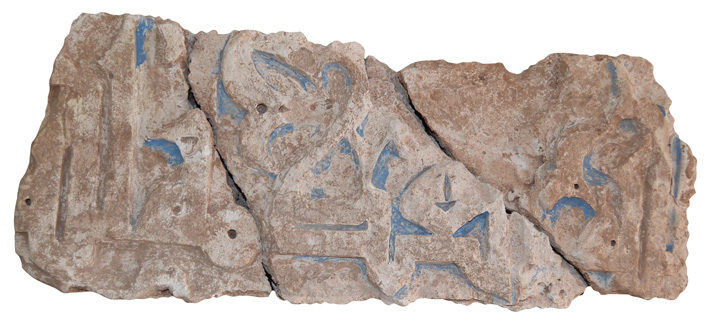
During the mid-eleventh century, farther south across the Atlas Mountains in the western Sahara, Yahya Ibn Ibrahim, the leader of the Sanhaja confederation of Berber tribes, long rivals of the Zenata Berbers, returned from a pilgrimage to Mecca with a desire to foster the devout practice of Islam among his tribes, who had learned what little they knew of the religion from passing caravan traders. Ibn Ibrahim enlisted the help of a devout man, Abdallah Ibn Yasin, from another tribe in his confederation, to help further unite the various groups—all with his eye on gaining control of the lucrative trans-Saharan trade. This confederation became the Almoravid Dynasty (1040–1147), whose name means “bound together in the cause of God.” Beginning in 1054, the Almoravids expanded their territory, eventually conquering places like Sijilmasa and Koumbi Saleh in neighboring Mauritania, a large city of the Ghana Empire where Capel has led an archaeological project. In 1058, the Almoravids defeated the Zenatas, took control of Aghmat, and declared it their capital.
When the Almoravids reached Aghmat in the eleventh century, it was already a highly developed and prosperous city. Excavations by Messier’s team have shown that a century earlier, its residents had built the large three-chambered hammam on the model of Roman bath complexes, with a cold room, a tepid room, and a hot room, a style seen widely in North Africa and southern Spain during the period. A domed reception room with an octagonal pool in the center would have welcomed visitors to the complex, which also had toilets and rooms for dressing. Although the dome over the reception room no longer stands today, the three main vaults remain largely intact. Under these vaults, archaeologists have uncovered parts of stone flooring and walls still covered in white lime plaster, as well as arched doorways with decorative brickwork connecting the rooms. According to Messier, this is the largest medieval hammam found in Morocco, and one of the biggest in the western Islamic world.

The team has also excavated a large palace complex and unearthed the remains of walls once decorated with floral designs carved in stucco and found a great deal of glazed cuerda seca pottery, a colorful style associated with the Andalusia region of southern Spain. Scholars have assumed that such pottery was imported to North Africa, where it has been uncovered at numerous archaeological sites, including Fez and Sijilmasa. But at Aghmat they discovered the first indications that cuerda seca pottery was also made locally. Although the team has yet to find the facilities where it was manufactured, Messier believes that the number of defective and incomplete pieces found at the site supports this interpretation. “You would not have imported unfinished and flawed pieces,” he says. Messier thinks that the quality of the pottery is evidence that the city likely had a large class of resident craftspeople in addition to the merchants who plied the trans-Saharan trade routes.
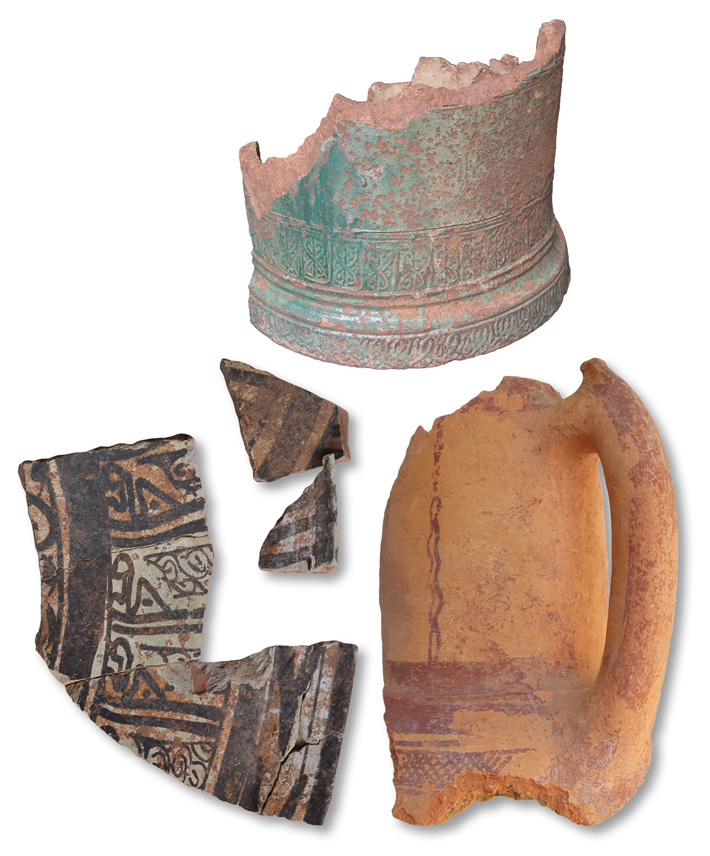
Aghmat’s palace was likely the home of the city’s most famous resident, Zaynab an-Nafzawiyya, the daughter of a successful merchant from Tunisia who settled there. Zaynab, who was married to three different rulers of the city, including two Almoravid governors, is one of the most prominent women in Islamic medieval history. “This woman was distinguished by her beauty and wealth,” writes the twelfth-century historian and mayor of Fez, Ibn Idhari. “She had praiseworthy virtues and an original mind.” Ibn Idhari is one of several Arabic sources who portray Zaynab as an Almoravid hero and credit her with the empire’s success in conquering parts of North Africa and Spain, including the lucrative gold trade routes. Although Zaynab stands out, her high standing was not so rare, explains historian Fatima Rhorchi of Moulay Ismail University. “We know from texts that elite women were involved in politics and promoting culture during the Almoravid Dynasty,” Rhorchi says. “Zaynab is one example of the level of emancipation that women had, at least those who belonged to the ruling classes.”
Near the palace, the team excavated a mosque, the remains of which consist largely of bases of pillars and parts of the mihrab, or prayer niche, and fragments of building material decorated with verses from the Koran and floral and geometric stucco designs similar to those found in the palace. Messier suspected at first that the rest of the mosque’s pillars had likely been carted off for reuse elsewhere. However, in 2014, a local construction crew installing new streetlight posts needed to dig up the modern road that runs through the site. There, Messier’s team found a wall of the mosque, and the remains of four pillars arranged at the corners of a square. Decorative tiles covered the floor, in the center of which the team identified the broken remains of a black flower-shaped stone basin, which had likely been used for ritual washing before prayers. This basin is referred to in the writings of Ibn al-Khatib, a historian from Granada, Spain, who visited Aghmat in 1360. He describes it as well-worn, implying it had been used for centuries before he saw it, likely stretching back to the days when the Almoravids occupied the city. “This discovery has deeply moved us all, not particularly because of the exceptional nature of this piece, but more precisely because this object is probably the only object in Aghmat that the texts speak of,” Capel says. “It’s really unusual to have textual evidence overlapping archaeological evidence. It was also very moving to feel life here, to feel human beings living in this place more than six hundred years after their society is gone.”
Further evidence of the mosque’s former grandeur was provided by a set of stone tracks carved in the floor that would have been used to roll the minbar—a large, usually wooden, pulpit from which the imam preached on Fridays—from the closet where it was traditionally kept during the week.
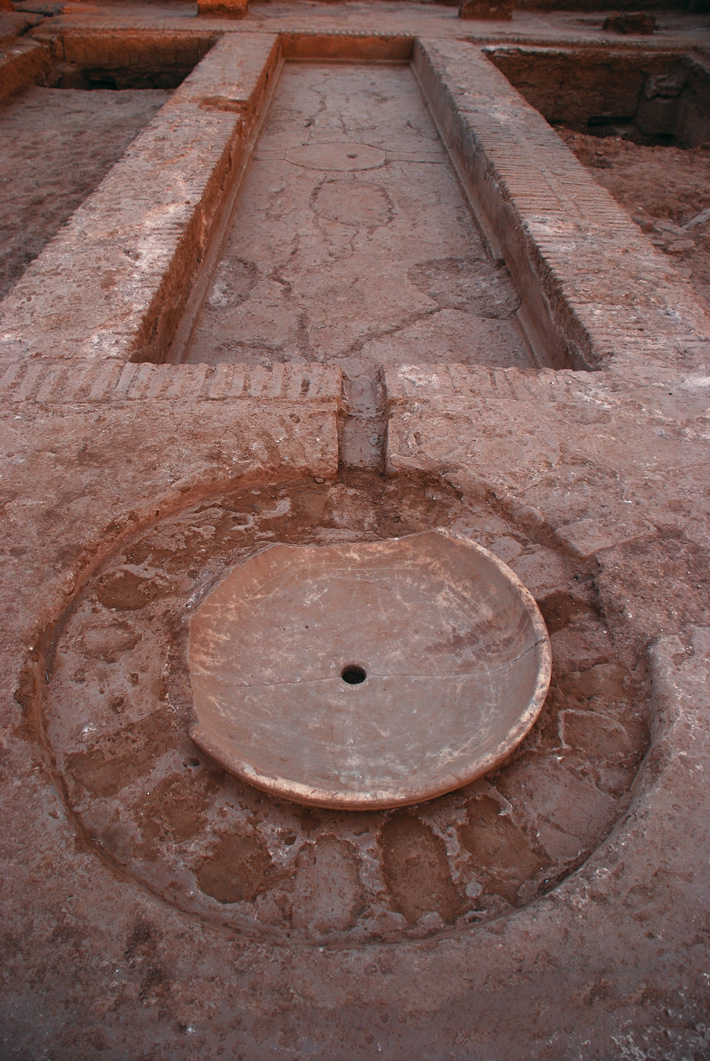
How much of Aghmat the Almoravids built is not yet clear. Capel says it’s possible that they constructed some new buildings, including the palace complex, as a way to differentiate themselves from previous residents and rulers, and to assert their power. However, just over a decade after they conquered the city, the Almoravids decided they needed a new capital. Messier thinks that, having hailed from the desert, they never felt safe in Aghmat, surrounded as they were on three sides by the foothills of the Atlas Mountains. In 1062, the Almoravids traveled 18 miles north, set up tents on a plain, and began constructing their new capital city of Marrakech. “Those 18 miles are flat as a pancake, so they could see an enemy coming,” Messier says. A few surviving remnants from the early days of Marrakech, including a highly decorated wooden minbar and a domed ablutions hall whose stone ceiling is etched with geometric designs, indicate the high level of craftsmanship the Almoravids marshalled in building their new city. The similarities between a washing basin found in Marrakech and the one found in Aghmat suggest to Messier that the Almoravids may have drawn on the older city as inspiration. “Aghmat is the precursor of Marrakech,” he says. Messier hopes to find other examples of how the old city influenced the new, but unlike Aghmat, Marrakech is a heavily built-up urban center of pink clay buildings, magnificent palaces, towering mosques, and winding alleyways of markets, and hence is difficult to excavate.
With the rise of Marrakech, which became a major stopping point for trans-Saharan caravans, Aghmat began to decline in economic importance, although the Almoravid royal family continued to live there. Yet even Marrakech’s sturdy walls and its location on the plain did not prevent the Almohads, another group of Berbers from the Atlas Mountains, from attacking Marrakech in 1147. This brought an end to the Almoravid Dynasty. Aghmat, however, endured for at least another 200 years. In 1154, the geographer al-Idrisi wrote that the people of Aghmat were “opulent, wealthy merchants who go into the land of Sudan with numbers of camels bearing immense sums,” and that there were “none richer.”
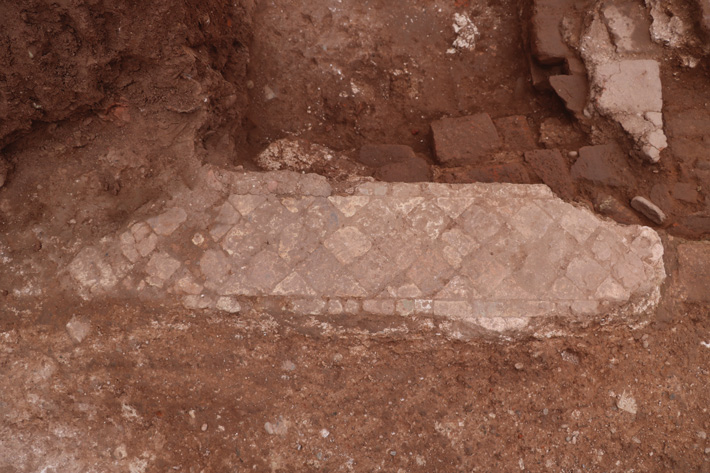
Messier’s team has found luxurious villas containing reflecting pools and intricate blue, grey, and white mosaic tile floors dating from this time. There are indications that these homes were maintained, and even renovated, through at least the late fourteenth century. But both the archaeological evidence and textual sources indicate that Aghmat, which had been an economic and cultural hub for 500 years, eventually became a rural settlement once again. The palace was emptied and its doors sealed in the late fourteenth century, and the hammam fell out of use. In the hammam, Messier has found trays for drying clay along with misfired clay objects, suggesting that much of the bathhouse’s space was converted to pottery workshops. The fifteenth-century Spanish traveler Luis del Marmol Carvajal writes that when he visited Aghmat, the once-opulent villas were occupied by Sufi mystics who spent their days working in their gardens, making simple pottery, and gathering at the mosque.
Today, the village of Ghmat is home to many traditional Berbers. They hold a large market every Friday where farmers sell live animals and produce, and where people from other Berber towns in the region arrive by bus, car, and donkey. People here still speak Tamazight, an endangered Berber language that the Moroccan government has officially recognized amid a resurgence of Berber identity. Aside from the ruins, another hint of the Berbers’ role in Aghmat’s storied past can be found at a domed mausoleum, renowned as the burial place of Muhammad Ibn Abbad al-Mu’tamid, a famous Arab poet and king of Seville in al-Andalus whom the Almoravids imprisoned in Aghmat after they conquered his former kingdom. This building reminds people that what looks like a simple village once attracted the region’s most powerful leaders and most influential intellectuals, both enemies and friends.


